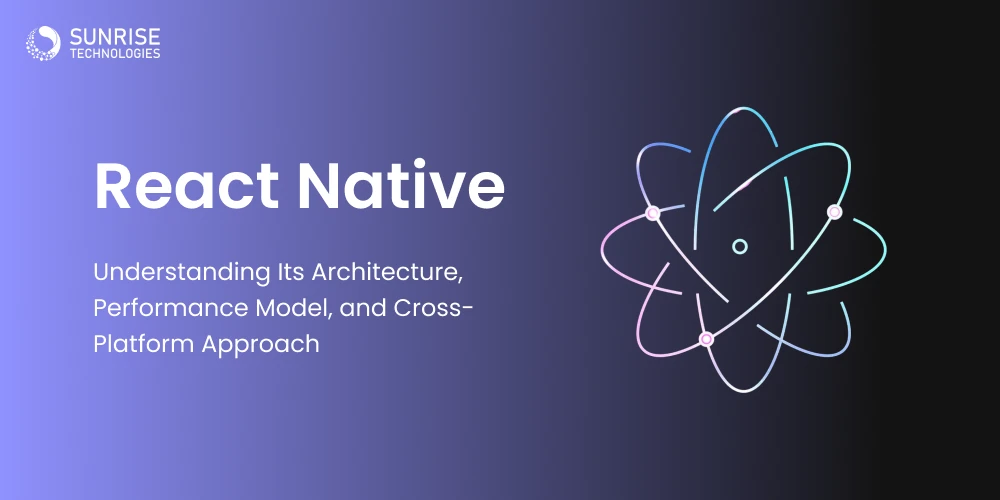
React Native: Understanding Its Architecture, Performance Model, and Cross-Platform Approach
Nov 17, 2025
React Native is a widely used framework that allows developers to build mobile applications using JavaScript and React while still relying on native platform capabilities. Created by Meta, it was designed around a simple idea: enable teams to share logic across platforms without sacrificing the native look and feel. Over the years, React Native has evolved into a mature cross-platform solution supported by an active open-source community and a rapidly advancing ecosystem.
This article explores how React Native works under the hood — its architecture, performance characteristics, and the mechanisms that allow it to deliver native experiences across multiple operating systems.
How React Native’s Architecture Works?
React Native applications execute JavaScript code independently from the native UI layer. Instead of converting React components into HTML or running them inside a web view, React Native maps these components directly to real native UI elements.
At the core of its original architecture is the JavaScript–Native Bridge, a communication layer that allows the JavaScript thread to interact with native platform APIs through asynchronous message passing.
- JavaScript handles all application logic.
- Native modules provide access to platform-specific features.
- The bridge transfers data between the two without blocking the UI.
This architecture enables React Native to reuse a significant amount of code across iOS and Android, while still interacting with native device capabilities like cameras, sensors, file systems, and storage. The clear separation between logic and UI rendering also supports faster development cycles, as JavaScript updates the interface while the system handles rendering using native UI components.
Moving Toward the New Architecture: Fabric Renderer
As applications became more complex, the limitations of the classic bridge model became more apparent — particularly around UI responsiveness and synchronization between threads. To overcome these challenges, the React Native team introduced Fabric, a modern rendering system designed to improve communication with native platforms.
Fabric brings several improvements:
- A unified C++ core that reduces overhead between threads.
- Better synchronization between the JavaScript environment and the native rendering pipeline.
- Support for concurrent features from newer versions of React.
Instead of relying solely on asynchronous batched updates, Fabric offers a more direct and predictable approach to managing layout and rendering. This leads to smoother transitions, more precise UI updates, and stronger support for advanced and interactive interfaces.
What Are the Steps to Connecting AI Tools with a Decades-Old Software System in Australia?
Performance is a crucial factor for mobile applications, especially on low-memory or mid-range devices. React Native addresses this through Hermes, a lightweight JavaScript engine optimized specifically for mobile environments.
Hermes improves performance by:
- Reducing application startup time through ahead-of-time bytecode compilation.
- Lowering memory usage by trimming unnecessary runtime features.
- Providing predictable execution paths designed for mobile CPUs.
Today, Hermes is the default engine for most React Native projects because it delivers noticeable improvements in responsiveness and cold-start performance—without requiring any additional code changes from developers.
How Cross-Platform Development Works in Practice
React Native’s cross-platform approach is built on the idea that business logic can often be shared, while UI components map directly to native interfaces. A React Native button is not a web button — it is the platform’s actual native button. This ensures React Native apps retain consistent platform-specific appearance and behavior even when most of the code is shared.
Developers typically:
- Write application logic in JavaScript or TypeScript.
- Use React Native components that correspond to native UI widgets.
- Extend functionality through platform-specific native modules when required.
Although a large portion of the codebase can be reused across platforms, React Native also supports platform-specific files (.ios.js, .android.js) for implementing unique behaviors when needed. This flexibility allows teams to fine-tune the final user experience while still benefiting from shared development.
Tooling and Ecosystem Considerations
React Native’s development workflow is supported by tools like the Metro bundler, community-driven native modules, and optional frameworks such as Expo. TypeScript has become increasingly common in React Native apps, as it adds type safety and clearer development patterns without changing how the underlying system works.
Because React Native targets multiple operating systems — including iOS, Android, Windows, macOS, and others — the ecosystem evolves continuously as device capabilities and platform standards advance.
Strengths and Trade-offs
React Native provides several advantages:
- Faster development cycles through shared business logic.
- Access to native platform capabilities.
- A large community ecosystem and mature tooling.
- Improved startup performance with Hermes and enhanced UI handling with Fabric.
However, like any technology, it comes with trade-offs:
- Highly animated or computation-heavy interfaces may require native modules or specialized libraries for optimal performance.
- Debugging across multiple platforms can add complexity.
- Third-party dependencies must be managed carefully to ensure compatibility with new OS releases.
These factors help development teams determine when React Native is the right fit and when fully native development may offer a better long-term solution.
Conclusion
React Native has grown far beyond its early “bridge-only” architecture. With the introduction of Fabric, Hermes, and improvements across the rendering pipeline, it continues to evolve toward a more predictable and performant cross-platform framework. Its ability to blend shared logic with native components makes it a strong choice for teams seeking efficiency without compromising on user experience.
By understanding how React Native works internally, developers and technical teams can make better decisions about architecture, performance needs, and long-term maintainability.
Published by Sunrise Technologies — Technical Insights
Sam is a chartered professional engineer with over 15 years of extensive experience in the software technology space. Over the years, Sam has held the position of Chief Technology Consultant for tech companies both in Australia and abroad before establishing his own software consulting firm in Sydney, Australia. In his current role, he manages a large team of developers and engineers across Australia and internationally, dedicated to delivering the best in software technology.









Cloud Based Project Management Platform
Read the challenges we faced and how we helped
View Case Study










